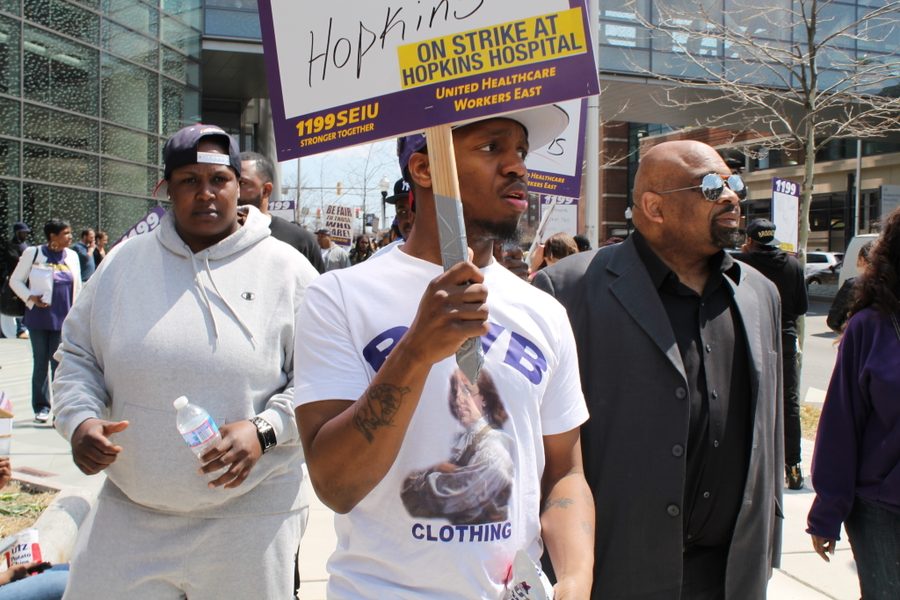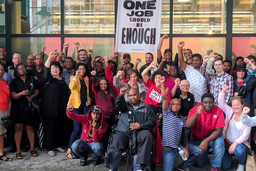
BALTIMORE — A bruising four-month fight between healthcare workers’ union 1199SEIU United Healthcare Workers East and Johns Hopkins Hospital is coming to an end: Members voted on Thursday and Friday to ratify a new agreement covering about 2,000 medical center employees.
The battle has been unusually intense compared with negotiations in the past, featuring a three-day strike in April and a voracious media campaign shaming the wealthy hospital for abandoning its lowest-paid workers. And though the new contract falls short of initial demands that would have more widely boosted wages among staff, local 1199SEIU leaders still view its ratification as a welcome victory after months of struggle.
“It was a tough negotiation. They are hard bargainers,” John Reid, Executive Vice President for 1199SEIU’s Maryland/District of Columbia region, tells In These Times about Hopkins representatives. “They act as if they have no respect for their own workforce.”
The contract, says 1199SEIU spokesperson Jim McNeill, calls for across-the-board wage increases of 2 percent a year in each of the first three years, followed by a 2.75 percent increase in 2017. In addition, it calls for a one-half percent salary bonus in the first year.
All in all, the union estimates, the employees whose salaries fall at the lower end of the scale could see a pay bump of an additional $4.30 per hour over the life of the four-and-a-half year contract.
Currently, the maintenance, food service and miscellaneous technical staff covered by the 1199SEIU agreement make an hourly minimum wage of $10.71. (The best-paid union members earn as much as $27.88 an hour.) By 2018, the new contract will have increased that to $13. Though that’s progress for Hopkins employees, many of whom have to rely on food stamps or other public assistance programs to get by, it’s not quite the $15-an-hour goal for which the union originally aimed.
Reid says this change stems from Johns Hopkins’ apparent unwillingness to acknowledge that its pay just isn’t high enough to support many staff members.
“We’ve moved forward, but it’s still just outrageous that a wealthy institution like Hopkins doesn’t understand that Baltimore workers need a living wage,” he continues. In Reid’s opinion, that living wage would amount to at least $15 an hour.
In order to garner support from other workers and the Baltimore public during its campaign, the union contrasted the modest incomes of maintenance and food-service staff at the hospital with the lavish compensation arrangements for the facility’s senior administrators. For example, according to an 1199SEIU analysis of public documents, Hopkins President Ronald Peterson was the highest-paid hospital executive in the state in 2012. And Internal Revenue Service Records show that the next year, he received a $1.2 million salary — plus a bonus of $455,714 and a one-time $11.9 million pension benefit based on his 40 years of service with the hospital.
Though Hopkins has been publicly mum about the issue thus far, the high pay for its executives is one indication of the elevated status enjoyed by the hospital and its related organizations in the Baltimore area. According to Hopkins spokesperson Kim Hoppe, the hospital’s parent organization Johns Hopkins Health Systems (JHHS) alone employs 20,000 workers at the sprawling East Baltimore medical complex; that number does not include the many others employed by Johns Hopkins University (JHU) elsewhere in the city. Taken together, JHHS and JHU are the largest employers in the entire state of Maryland.
Hopkins exerts such powerful regional weight that even nominally pro-labor elected officials such as Gov. Martin O’Malley (D) and Mayor Stephanie Rawlings-Blake (D) appeared fearful of backing the union in its wage fight. Neither publicly endorsed the union’s contract campaign, and Rawlings-Blake even turned down an invitation to speak at a public 1199SEIU rally at the city’s Inner Harbor in early May.
O’Malley did ask the two sides to return to the bargaining table in late June, when a second strike at the hospital appeared imminent, but the union did not seek that intervention, Reid says.
And Hopkins’ wide-ranging influence will mean that its now-ratified contract with 1199SEIU will have an impact beyond the facility’s campus. The union has collective bargaining agreements with Sinai Hospital and Greater Baltimore Medical Center, two other hospitals in the Baltimore metro area. Those contracts, Reid notes, have historically followed the pattern set by Hopkins.
“I think that Hopkins sets the standard in Baltimore. The other hospitals, even the non-union hospitals, will keep pace with Hopkins,” he says.







